UK immigration policy after leaving the EU: impacts on Scotland's economy, population and society
Debut report by independent Expert Advisory Group on Migration and Population looks specifically at how the ending of free movement and future UK Immigration policy will affect Scotland's devolved responsibilities.
3 Labour Market Effects
This chapter focuses on the impacts of the proposed Tier 2 changes on the Scottish labour market. Having established the size and distribution of the contributions that migrants make to the Scottish labour market in Chapter 2, we now consider how labour migration may be affected by the proposals contained in the White Paper.
3.1 Tier 2 Skills and Income Thresholds
The White Paper proposes abolishing the general cap on Tier 2, and lowering the skills threshold to include medium-skilled jobs at RQF3 or above. This is likely to expand the use of Tier 2, both by removing restrictions on the number of people employed, and increasing the range of eligible occupations. The removal of the resident labour market test and simplification in the sponsorship system may make the use of Tier 2 more appealing to a wider range of employers. The distribution of RQF levels in Scotland by country of birth is shown in Figure 3.1.
Those born outside the UK tend to be more concentrated at the extremes of the qualifications distribution. Thus, for example, the proportion of those born in the EU who hold a PhD is more than three times the equivalent UK share. But the proportion of unskilled labour from the EU-10 countries is more than double the UK proportion. This implies that there are likely to be fewer migrants in the middle of the income distribution than there are UK-born.
Figure 3.1: Regulated Qualifications Framework (RQF) and Country of Birth
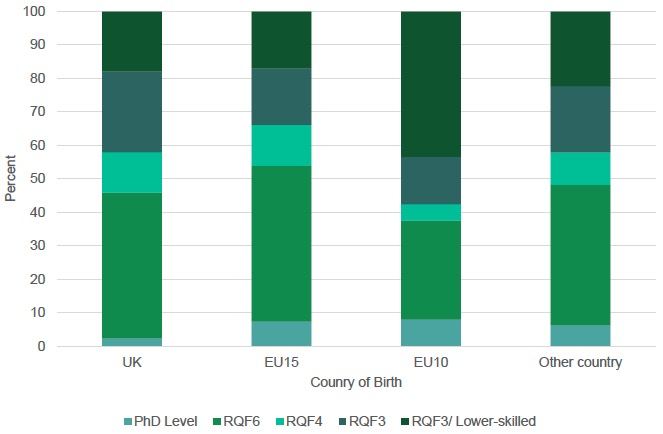
Source: ONS Labour Force Survey 2013-2017
Table 3.1 shows estimated annual earnings in Scotland by country of birth and level of qualification based on the LFS 2013-2017 dataset. Consistent with the argument above, the range of earnings is wider for those born outside the UK than the UK‑born. For example, median earnings for those born in the EU-15 with PhD level qualifications exceeds £54,200 while their low-skilled counterparts earn only £16,900. These compare with £35,200 and £18,500 for equivalent levels of skill among the UK-born.
Table 3.1: Median Annual Salary by Level of Qualification and Country of Birth
| PhD |
RQF6 |
RQF4 |
RQF3 |
RQF3 |
Lower-skilled |
All |
|
|---|---|---|---|---|---|---|---|
| UK |
£35,200 |
£34,400 |
£25,600 |
£23,100 |
£18,100 |
£14,500 |
£20,900 |
| EU-15 |
£54,200 |
£30,100 |
£22,900 |
£24,100 |
£14,100 |
£16,900 |
£22,800 |
| EU-10 |
£40,200 |
£31,700 |
N/A |
£18,300 |
£13,300 |
£14,600 |
£14,800 |
| non-EU |
£35,100 |
£32,700 |
£23,100 |
£22,600 |
£15,700 |
£14,100 |
£19,000 |
| All |
£35,200 |
£34,200 |
£25,300 |
£23,100 |
£17,600 |
£14,500 |
£20,800 |
Source: ONS Labour Force Survey 2013-2017
The White Paper proposes a £30,000 salary threshold for Tier 2 migrants (or a lower threshold, subject to consultation). The LFS estimate of overall median earnings in Scotland for the 2013-17 period is £20,800. Table 3.2 also shows that median earnings for both UK and non-UK workers, with skill level RQF4 or less, falls well short of the proposed salary threshold. However, median earnings are not informative about the proportion of the distribution that exceeds the threshold. In addition, the survey data from the LFS is potentially subject to bias for a number of reasons such as the level of proxy responses and low response rates at the upper and lower ends of the earnings distribution. It is difficult to assess the direction of these biases. In the remainder of the chapter, we analyse the implications of the proposed threshold in more detail, but for this analysis we rely on the Annual Survey of Hours and Earnings (ASHE), which is collected by the ONS and is based on employer records rather than survey data.
3.2 Effects on different sectors
We identify the types of work and worker likely to be most affected by the proposed restrictions on EU migration by analysing the distribution of annual earnings in Scotland for different groups within the workforce. We focus in particular on the proportion of employees whose annual earnings exceed the proposed income threshold.
The calculations are based on published tables from ASHE 2018 . Note that our analysis is restricted to employees, given that income data for the self-employed is not available in this dataset. Figure 3.2 shows the distribution of gross annual earnings in Scotland in 2018 based on ASHE. The tables contain data on the 10th, 20th, 30th etc. percentiles of this distribution. We fit a quadratic function to these percentiles to interpolate the proportion of earnings that are less than specified income thresholds.
Figure 3.2: Distribution of Annual Earnings in Scotland 2018
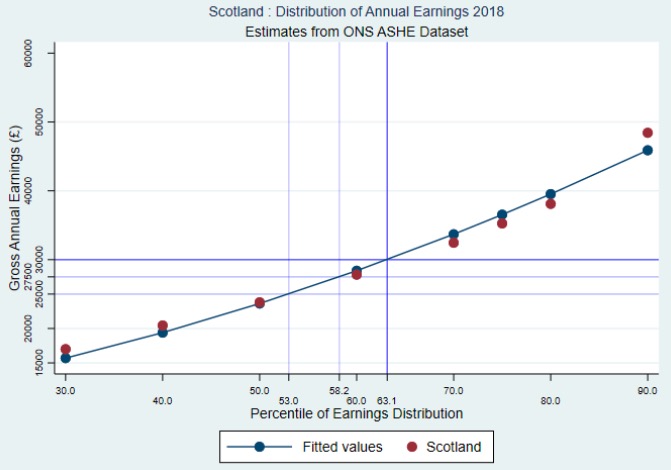
Source: ONS Annual Survey of Hours and Earnings 2018
The results show that around 63% of all employees in Scotland earn less than £30,000 and therefore fall below the proposed Tier 2 income threshold. To assess the implications of alternative threshold measures, we also carry out sensitivity analyses for lower thresholds of £27,500 and £25,000. In these cases, 58% and 53% of Scottish employees earn less than £27,500 and £25,000 respectively.
For a more detailed analysis, we first analyse the distribution of earnings by occupation. Figure 3.3 shows the proportion of jobs in broad occupational groups where annual earnings exceed thresholds again set at £30,000, £27,500 and £25,000. The results show that over 70% of jobs in science, research, engineering and technology have earnings exceeding the £30,000 threshold. Reducing the threshold to £25,000 increases this proportion to almost 90%. At the other end of the earnings spectrum, it is unlikely that any jobs in secretarial work, textiles, social care, leisure and travel, sales and elementary occupations would qualify if the Tier 2 income threshold was set at £30,000. Reducing the threshold to either £27,500 or £25,000 makes relatively little difference since these are low-wage occupations. Even the application of a lower Tier 2 income threshold would effectively bar non-UK migrants from these occupations.
Figure 3.3: Proportions of Jobs with Incomes Exceeding Thresholds of £30,000, £27,500, and £25,000 by Occupation in 2018
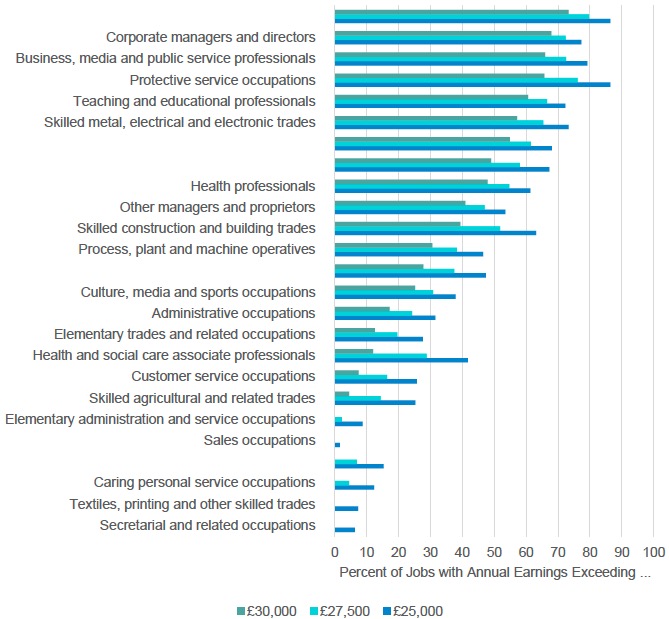
Source: ONS Annual Survey of Hours and Earnings 2018
These calculations include both UK-born and non-UK born workers in Scotland, since the ASHE dataset does not record country of birth. There is considerable overlap between low-wage occupations and occupations which employ a large share of migrant workers (see Chapter 2). For example, earnings in cleaning, processing and hospitality are typically low: they also employ a relatively large share of EU-10 workers. Recruitment to these occupations, particularly where turnover is high, is likely to be challenging if the proposed Tier 2 limit is adopted.
Scottish employers may respond to labour shortages by increasing investment, enhancing the skill levels of existing employees, more active recruiting of UK-born workers and/or increasing wage rates. Almost all of these courses of action would lead to increased costs. These may be passed on to consumers if market conditions permit. If they cannot be passed on, profitability would suffer.
The White Paper on migrationargues that the increased availability of labour resulting from free movement within the EU has led to an overreliance on low-paid migrant workers. In order to reduce this reliance, it proposes that employers of migrants earning close to the £30,000 threshold might simply increase their wages above this threshold, but it explicitly avoids discussing the consequences of such adjustments for costs, competitiveness and ultimately for economic output. Reductions in labour supply that follow from the application of a salary threshold to EU migration may generate increased investment in both capital and skills but how far these are economically viable will vary both by occupation and location.
These issues will confront Scottish employers to varying degrees in industries that are dependent on EU workers. Some of the challenges for sectors have been highlighted by organisations such as the Confederation of British Industry, the Federation of Small Businesses, the Scottish Tourism Alliance, Care Scotland and National Farmers' Union Scotland. In the next sections we provide examples of two sectors in Scotland that are likely to be negatively affected by the changes to immigration rules.
3.2 The cases of Social Care and Seasonal Agriculture
Social Care
One part of Scotland's economy likely to be substantially affected by new regulations on EU migration is the social care sector. The demand for care, particularly for older people, has grown substantially in recent years. We would expect that growth to continue. Our projections show that between 2016 and 2037, the number of those aged 80 and over in Scotland will increase by 68% (see Chapter 4). Increased demand for care provision will follow, given the prevalence of frailty and long-term health conditions in this age group.
The social care sector combines a number of unusual features:
- It is largely monopsonistic, with many suppliers and one dominant group of purchasers – local authorities. This structure has resulted in downward pressure on prices, impairing profitability and driving many providers out of the market. Local authorities are the principal providers because individuals typically do not have enough savings to meet care costs. Further, the budgets of local authorities across the UK have seen substantial reductions over the past years. However, the share of self-funding residents, who do cover the full costs of their care, is lower in Scotland than in England, which makes Scottish providers more reliant on local authority supported clients.
- These developments have inevitably affected the wages that care providers are able to offer. Workers in monopsonistic industries are typically low-paid, and the recent budgetary squeeze has added to the downward pressure on care workers' wages. The Scottish Government has partially alleviated this pressure by supporting the introduction of the Living Wage in the care sector.
- Low wages have reduced the incentive for care workers to invest in training and the inability of care providers to make normal profits has reduced their capacity to subsidise workers' training.
- The care sector does not lend itself easily to capital/labour substitution. It is a labour-intensive sector with little immediate prospect of technical change. Artificial intelligence is a long way from providing empathetic companionship, which is an essential component of the care worker's vocation. Neither is this skill valued in the current migration proposals.
- It is not clear that the market price for care reflects its true societal value, even if the market were competitive. Research has estimated that the value of unpaid family caregiving is equivalent to between 20% and 36% of GDP.[10] Feminist economists have long argued that care is not properly dealt with in conventional GDP accounting and that governments, as evidenced by their policy choices, have consistently failed to recognise its important contribution to social welfare.
Given its unique structure, there is a strong case that the wages paid to care workers are an inadequate reflection of their contribution to societal welfare. However, the UK Government's migration proposals elide market wages and societal value. The proposals for classifying potential migrants are based solely on market wages.
The care sector in Scotland currently faces many challenges, including a significant excess demand for care workers. This is evidenced by the most recent Scottish Care employer survey, which indicated that 77% of care homes were having recruitment difficulties.[11] There are staff vacancies of around 20% in nursing posts in care homes.
EU workers make up a significant proportion of Scotland's care workforce. Our estimate from the LFS is that since 2015, around 9.1% of the workforce were born outside the UK, with 38.5% of these coming from the EU. This estimate is lower than that of Care Scotland: the LFS estimate may be biased downwards if its postcode-based sampling frame fails to capture adequately the addresses of migrants. Care Scotland reports that EU workers have been a particular target for recruitment to the sector in recent years, although difficulties have been experienced recently on recruitment due to the negative effects of preparations for the UK's departure from the EU.
As shown in Figure 3.3, the 2018 ASHE data suggests that less than 10% of those working in “Caring and personal service occupations” in Scotland earn £25,000, and none earn more than £30,000. Under current Home Office regulations, the majority of care workers are classed as 'lower skilled,'[12] and therefore would also not qualify under the proposal to extend the skilled route for migrants to RQF3+ (Highers or equivalent) provided that they meet the £30,000 per annum income threshold.[13]
The White Paper proposes that workers at any skill level coming from unspecified “low risk” countries would continue to have access to the UK labour market for a limited period of time, to be reviewed in 2025. This would enable employers in the care sector to continue to seek workers from Europe. But these workers could only be offered a 12‑month contract, and would have no access to public funds or entitlement to bring dependents. After the initial 12-month period, re-entry would not be possible until a further 12 months had elapsed. These terms are unlikely to be attractive to prospective EU recruits to the sector, and are therefore likely to further exacerbate the difficulties facing care service providers.
The care sector is already experiencing high staff turnover, with the added stress of covering existing vacancies leading to more staff leaving the sector. Even if there were an adequate supply of staff from EU countries, the 12-month tenure limit will prevent them from building a significant career in the UK. This will contribute to continuing instability within the sector, and will make it more challenging to adjust to the rapid growth in the number of older people in Scotland that will occur over the next decade. Instability in this sector may also have knock-on effects for the NHS by increasing delayed discharge if social care options are constrained by staff shortages. This would have an adverse effect both on NHS finances and on patient outcomes.
Finally, previous analyses of the costs and benefits of migration have largely failed to account for the economic impact of substitution between paid and unpaid care. If there are insufficient paid-for care workers to meet demand, the likely response is an increase in unpaid care by friends and family, some of which will result in reduced labour market participation. Recent research finds that unpaid care has a negative effect both on working time and wages and that this effect is particularly pronounced for women.[14] Thus, female care providers decrease working time by between three and ten hours per week and face a wage rate 3% lower than non-caregivers. The implication is that a restriction on the supply of care workers is likely to adversely affect the labour market prospects of friends and family, particularly female family members. The fiscal effects of this substitution will be reduced income tax revenues and higher payments of welfare benefits. There are also likely to be higher health costs, since caregiving tends to have adverse health impacts.[15]
Seasonal Agricultural Workers
Employers of seasonal agricultural workers in Scotland will face additional challenges if the supply of such workers is significantly constrained. Around 9,300 seasonal workers were engaged in Scottish agriculture in 2017.[16] They were particularly concentrated in fruit production. This sector has been an important source of growth within Scottish agriculture in recent years (see Figure 3.4). The value of its output grew to almost £140 million in 2017, while the volume of production has more than tripled since 2003. Food production in general has been growing more rapidly in Scotland than in the rest of the UK.
Figure 3.4: Fruit Production in Scotland by Value of Production, 2003-2017 (£m)
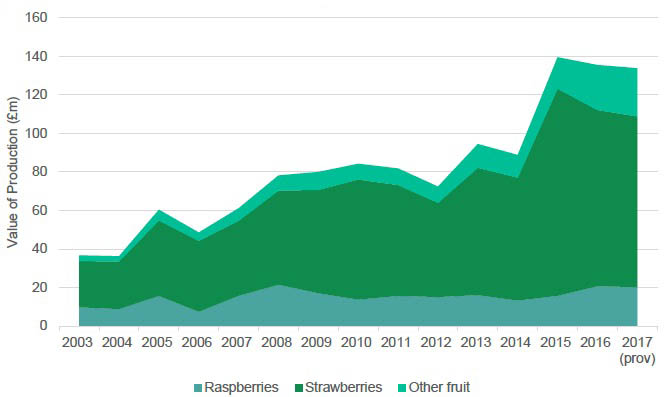
Source: Economic Report on Scottish Agriculture 2018
A recent survey of the sector indicated that labour shortages were evident in 2017, with 48% of respondents indicating that they had difficulty harvesting due to labour shortages.[17] Without access to sufficient seasonal labour 58% of respondents were 'likely' or 'very likely' to downsize their business, while 42% would cease their current activity. Other actions, such as increasing wages or seeking more capital-intensive production methods, were favoured by 61% and 52% of respondents respectively (the categories were not exclusive). However, there are no viable mechanical options currently available to harvest soft fruit.
The UK Government proposes that existing arrangements for seasonal workers will continue until the end of the implementation period if an exit deal is agreed between the UK and the EU. In the event of a no deal, the UK Government has committed to temporary transitional arrangements lasting until 31 December 2020. Thus employers should be able to continue hiring workers from the EU. However, Scottish fruit businesses have already been forced to abandon production due to shortages of staff. The current uncertainty over migration arrangements is likely to make hiring EU workers even more challenging.
The UK Government proposal under no deal is that workers wishing to stay for more than three months will have to apply to the Home Office for leave to remain within three months of their arrival. Leave to remain will normally be granted for 36 months and this will include permission to work. However, in choosing where to work, potential migrants will weigh up the costs of this procedure against alternatives within the EU that do not involve such bureaucratic hurdles, the outcome of which cannot be predicted with certainty. This suggests that existing recruitment difficulties are only likely to become more acute.
To allay producer concerns, the UK Government has established a pilot scheme for non-EU seasonal workers. This will operate in 2019-20 and will involve up to 2,500 workers from outside the EU. In line with the MAC recommendation, the scheme is expected to require that workers be paid at a rate above the minimum wage so that it should not be seen as an 'easy option' for employers. The visas issued under this scheme are expected to cover the whole of the UK. The quota is far lower than the 21,250 workers admitted annually in the previous SAWS, which ran until 2016. Under that scheme, around 14.6% of the workers admitted were employed in Scotland, predominantly in Angus (1,143, or 5.7% of the UK total), Perth and Kinross (4.8%), Fife (2.3%) and Aberdeenshire (1.4%).[18] If we assume a similar proportion of 14.6% under the new scheme, that would imply just 365 workers coming to Scotland under the pilot. This will clearly not come close to replacing the EU workers that have been regularly coming to Scotland in recent years, and without whom this sector of Scottish agriculture cannot be sustained in its present form. Unless the pilot is significantly expanded, this sector which is currently thriving will be forced into less profitable alternatives.
Producers have the option of local recruitment, but this appears unlikely to succeed unless wages are increased to a level that makes the final product uncompetitive. And in the absence of a mechanical harvesting solution, at least in the short term, the likely response is for producers to convert to other forms of production. Given the revealed preference for fruit production, these alternatives are likely to be less profitable. Agricultural policy as a whole will be in a state of flux as a result of leaving the EU, and these developments are likely to weaken business confidence in Scottish agriculture, which provides an important underpinning for Scotland's rapidly growing food and drink sector.
3.3 Migrant Characteristics and Income Thresholds
Applying a uniform income threshold will change the composition of EU migrants to Scotland due to the differential effects of a single threshold on different types of workers. In this section, we consider how the income threshold may affect the age, gender and spatial balance of EU migrants to Scotland.
As we have shown in Chapter 2, migrants to Scotland (and rUK) have typically been young, with net migrant flows dominated by those aged 20-29. This is in line with standard human capital theory, which suggests that most migrants move in order to improve their prospects and therefore will do so before they reach their peak earnings. This implies that they will find it more difficult to meet income threshold requirements than older workers who have reached their peak earnings level. The MAC recommended lower salary thresholds for young people and the UK Government has accepted this. In its recent White Paper it argued that 'graduate entrant jobs are already subject to a lower salary threshold and we intend to continue with that approach to ensure that those at the start of their careers are able to access the job market.'[19] The current threshold for new entrants within the general Tier 2 route, and graduate trainees within Tier 2 (intra‑company transfer), is set at £23,000.
Figure 3.5 is also drawn from the 2018 ASHE data. It shows the proportion of jobs that are held by different age groups and which exceed the Tier 2 £30,000 income threshold. It is for the UK as a whole rather than Scotland because ONS does not publish data on earnings by region and age. Nevertheless, patterns for Scotland are likely to be very similar to those for the UK as a whole. It shows that only around one quarter of jobs held by those aged 22-29 receive earnings that exceed £30,000. This proportion rises sharply for those in their 30s and 40s, but migration is much less common amongst these age groups.
Figure 3.5: Proportion of UK employees with earnings in excess of £30,000 by age
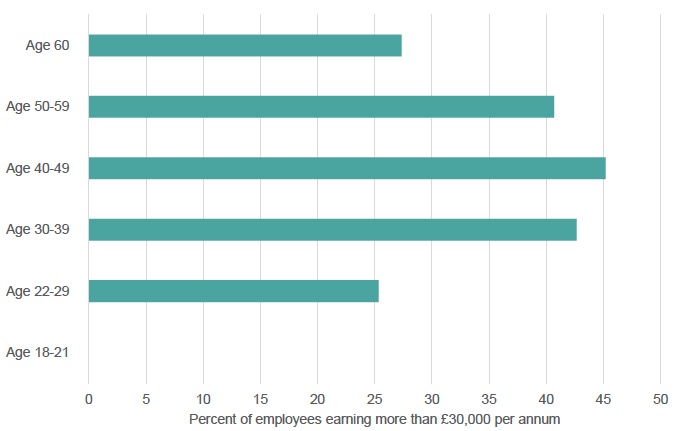
Source: ONS Annual Survey of Hours and Earnings 2018
The Tier 2 salary threshold will have a disproportionate effect on the supply of female migrants. Figure 3.6 shows the proportion of jobs held by women where earnings exceed £30,000 per annum.[20] The proportions for women are much lower than those for all workers shown in Figure 3.3, which suggests that women wishing to migrate to Scotland for employment purposes will be significantly less likely than men to earn sufficient to qualify under the Tier 2 proposals.
Figure 3.6: Proportion of female employees in Scotland with annual earnings in excess of £30,000, £27,500 and £25,000
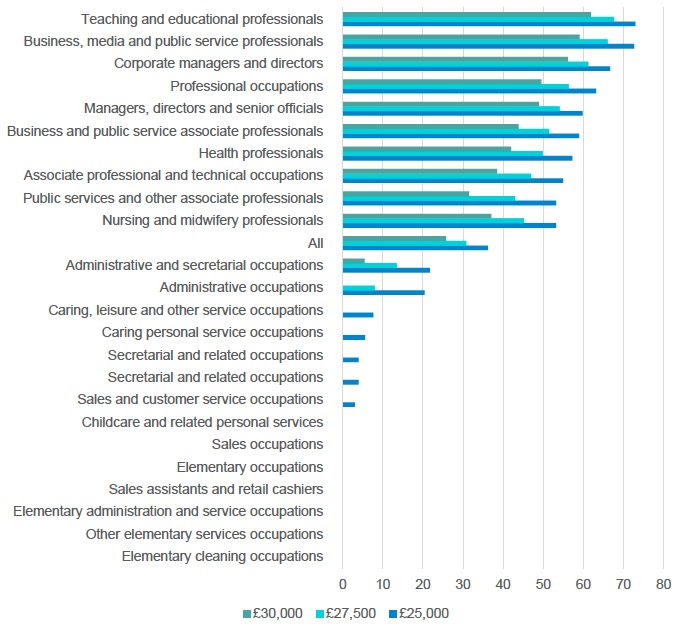
Source: ONS Annual Survey of Hours and Earnings 2018
This in turn has implications for the supply of labour to particular occupations, given that female employment tends to be clustered in a relatively small number of occupations. There is a wide range of occupations where the proportion earning more than a significantly lower threshold of £25,000 is zero. Those occupations where even a moderate proportion of women earn above £30,000 tend to be in professional and/or public sector jobs.
3.4 Spatial Effects
We now examine how the threshold might affect the geographical distribution of migrants across different areas of Scotland. We analysed differences in income across Scotland's local authorities. Figure 3.7 shows the proportions of employee annual earnings which exceeded £30,000, £27,500 or £25,000 in 2018. There is wide variation in this proportion across Scotland's local authorities, ranging from 16% in Na h-Eileanan Siar to 50% in East Renfrewshire. This suggests that few potential migrants to areas such as Na h‑Eileanan Siar, Dumfries and Galloway or Clackmannanshire would find jobs with pay levels sufficient to qualify under the proposed Tier 2 thresholds.
Figure 3.7: Proportion of employees in Scottish local authorities with annual earnings in excess of £30,000, £27,500, and £25,000 in 2018
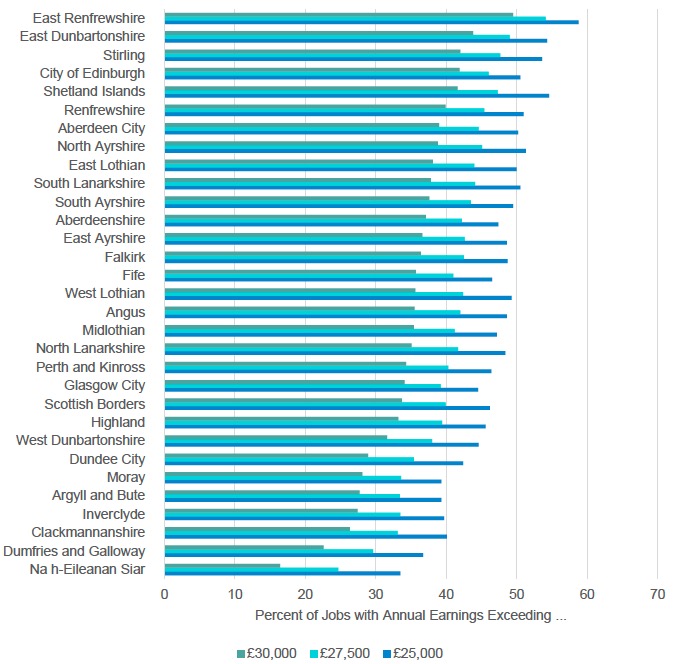
Source: Annual Survey of Hours and Earnings 2018
Figure 3.7 also shows that relaxing the Tier 2 income threshold to £27,500 or £25,000 would substantially increase the range of jobs available to migrants. If the threshold is reduced to £25,000, only five local authorities would have less than 40% of jobs meeting this threshold.
This variation within Scotland is of course repeated elsewhere in the UK. The White Paper proposes that there should be no variation in the income threshold across the UK. Given that it is also acknowledged that migration generally has a beneficial effect on productivity, the lack of access to migrants in areas that already experience low levels of productivity as evidenced by their low wages will further exacerbate economic and social inequality within the UK.
Figure 3.8 shows the proportion of female jobs where earnings exceed £30,000 per annum by local authority. Again there is wide variation across local authorities suggesting that the opportunities for females to migrate to different parts of Scotland to work varies greatly.
Figure 3.8: Proportion of female employees in Scottish local authority areas with annual earnings in excess of £30,000 in 2018[21]
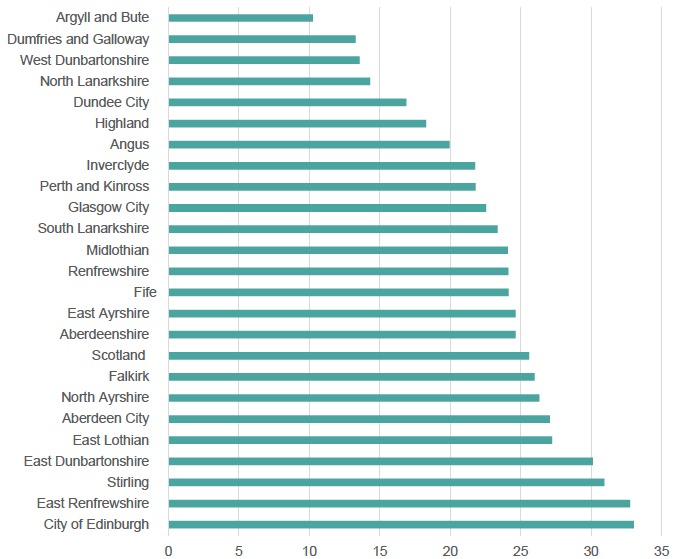
Source: ONS Annual Survey of Hours and Earnings
Summary and Implications
The proposed changes to free movement and to Tier 2 are likely to significantly reduce inflows of EU migrants for the purpose of work. Analysis using ASHE data shows that 63% of employees in Scotland (both UK and non-UK nationals) earn less than the Tier 2 salary threshold of £30,000. If we take possible alternative salary thresholds, the proportions would be 58% (earning less than £27,500) and 53% (earning less than £25,000).
This threshold would affect sectors differentially. In some sectors, such as science, research, engineering and technology, 70% of employees earn over £30,000. By contrast, it is highly unlikely that any jobs in secretarial work, textiles, social care, leisure and travel, sales and elementary occupations would quality for the £30,000 threshold. We analysed two sectors that are likely to be detrimentally affected: social care and seasonal agriculture. In the social care sector, less than 10% of those in caring personal service occupations in Scotland earn above £25,000, and none earn £30,000. The budgetary pressures faced by local authorities, the main purchaser of social care services, mean that there is little prospect of raising salaries in social care to a level that would attract UK workers. The brunt of these shortages is likely to be borne by friends and family who will have to assume responsibility for care, and especially female family members, whose labour market prospects will be detrimentally affected.
We also looked at the distribution of salaries across age groups, gender, and region. Most of those earning above £30,000 are in their 30s to 40s, with a much smaller proportion (25%) of people in the 22-29 age group earning at this level. Given that migrants tend to be younger than the average population, only a small portion are likely to qualify under the proposed Tier 2 scheme.
We also found a significant gender differential in the distribution of salaries, with a lower proportion of women earning over £30,000 across almost all sectors. Many of the occupations in which women work would not meet the £30,000 or even a potential £25,000 threshold, implying that the proposed Tier 2 arrangements would create a gender disparity in the supply of future migrants.
Finally, there are striking divergences in how salary levels are distributed across areas of Scotland. Thus while 49.5% employees in East Renfrewshire earn above £30,000, only 16% reach this threshold in Na h-Eileanan Siar. This implies that very few immigrants would be able to move to less prosperous local authorities under Tier 2 income thresholds. This would limit labour migration in areas of Scotland that already experience low levels of productivity and face challenges of depopulation.
Contact
Email: Neil Meehan
There is a problem
Thanks for your feedback